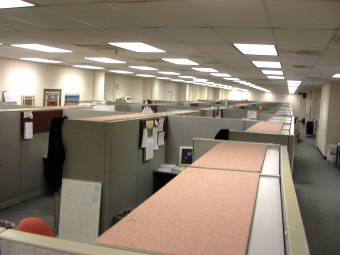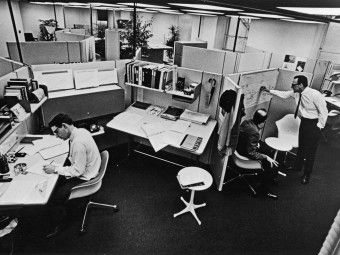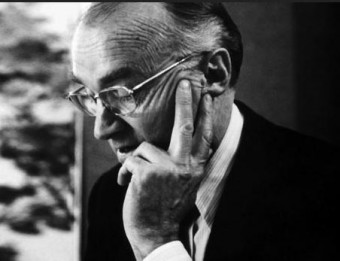Who Invented the Cubicle?
 Audiences cheered when the hero of the 1999 movie Office Space unscrewed the walls of his cubicle and watched them come crashing down. Yet 30 years earlier, when the very first cubicle walls went up, employers and workers alike cheered them as the “workplace of the future.”
Audiences cheered when the hero of the 1999 movie Office Space unscrewed the walls of his cubicle and watched them come crashing down. Yet 30 years earlier, when the very first cubicle walls went up, employers and workers alike cheered them as the “workplace of the future.”
SEA OF DESKS
“Today’s office is a wasteland. It saps vitality, blocks talent, frustrates accomplishment. It is the daily scene of unfulfilled intentions and failed effort.”
That may read like a critique of the modern corporate office, but it was written by an inventor named Bob Propst in 1960. Propst went to work in post-World War II America, just after the majority of the U.S. workforce had shifted from factory jobs to office jobs—“pencil pushers,” as they were called. Their typical workplaces were giant rooms full of rows of desks laid out in a grid, all facing the same direction. The average pencil pusher’s view: the back of a fellow worker’s head. No one had any privacy, but that didn’t matter too much, because workers were discouraged from talking to each other. They had few places to store work papers and personal items, other than an inbox on top of their desk and maybe a drawer or two below. “Here were large numbers of intelligent people working on complex tasks,” said Propst about an aviation company he’d worked at in the 1950s, “acres of them hunched over their desks, trying to create.”
SYSTEMS INTEGRATION
As a sculptor, designer, and former college art professor, Propst specialized not so much in inventing new things but in revamping entire systems (he’d previously designed new quality controls for manufacturing concrete and a more ergonomic cockpit for supersonic jet pilots). Setting his sights on creating a better workplace, in 1958 Propst signed on as head of research and development at the Michigan-based office furniture company Herman Miller Inc.
How could Propst and his design team give office workers more privacy and autonomy, yet still maintain the open environment that he felt would facilitate interaction and communication? First, Propst had to find out what made workers tick, so he interviewed hundreds of them and their bosses, as well as doctors, psychologists, anthropologists, architects, and mathematicians.
Propst also studied a new kind of workplace gaining popularity in Germany called Bürolandschaft, or “office landscape.” Based on socialist principles that encouraged working together as a group, this system eliminated the grid and—depending on the workers’ duties—turned some desks to face each other, placed others side by side, and put still others in a circle. In addition, the file cabinets and bookshelves, usually set along the office’s perimeter, were pulled away from the walls and put in the middle of the room, creating makeshift privacy dividers. Potted plants were strategically placed throughout the room to complete the “landscape” motif. Propst borrowed elements of Bürolandschaft and improved on it to create what Herman Miller called the “Action Office.”
BUILDING BLOCKS
The first design, released in 1964, was a single, freestanding piece of furniture that included bins and a few shelves on each side. The biggest selling point: Employers could place these units anywhere they saw fit. Sales were slow at first, but Propst and his team kept working on the full version—which would feature the floor units attached to partition walls that could be joined to each other in different configurations. In 1968 Herman Miller released the complete Action Office, touted as “the world’s first open-plan office system of reconfigurable components.”
- The entire workroom floor consisted of both common and private spaces. Workers were urged to move from one to the other several times throughout the day. Potted plants and bright walls spruced up the mood even more.
- Each desk was surrounded by three attachable dividers, or walls, which were high enough to give some privacy but not so high that the worker couldn’t stand up and see the rest of the workroom (a practice that would later be called “prairie dogging”).
- These walls didn’t connect at 90-degree angles: The angles were much wider, allowing for a more open space. This irregular geometry was designed to facilitate “organic circulation patterns” that would keep movement—and productivity—flowing.
- The old desktop inbox was replaced with slanted wall slots allowing files for several different projects to be off the desk but still within arm’s reach.
- Soft boards and plenty of thumbtacks let employees personalize their spaces and keep important papers in full sight.
- The height of the desktops varied in places, which encouraged workers to change their posture frequently and even stand up while they worked in order to keep their blood flowing. (Though Propst was a big proponent of this practice, it never really caught on.)
- Perhaps most important of all: Action Office allowed managers to customize their constantly changing workplaces for a fraction of the cost (and downtime) that would have been required by hiring architects and contractors to do the job.
ACTION OFFICE3
 In 1968 Intel, a new technology company in Santa Clara, California—located in the heart of what would later be called Silicon Valley—became one of the first to incorporate Propst’s system. Hundreds more companies (both startups and established ones) placed orders for Action Offices, and Herman Miller raked in over $25 million in corporate sales in the first two years alone. As the 1970s ensued, workplaces across the United States steadily switched from rows of desks to partitioned walls. By the end of the decade, the average workspace area was 12 feet by 12 feet.
In 1968 Intel, a new technology company in Santa Clara, California—located in the heart of what would later be called Silicon Valley—became one of the first to incorporate Propst’s system. Hundreds more companies (both startups and established ones) placed orders for Action Offices, and Herman Miller raked in over $25 million in corporate sales in the first two years alone. As the 1970s ensued, workplaces across the United States steadily switched from rows of desks to partitioned walls. By the end of the decade, the average workspace area was 12 feet by 12 feet.
Then, in the 1980s, the Digital Revolution took hold. The Action Office system (and the dozens of copycats that followed) could easily fit a computer, monitor, and printer. Sure, those early computers were much larger than today’s sleek PCs and Macs, but the Action Office was spacious enough to handle them. At least that’s how it was supposed to work. But as office rents skyrocketed in the 1990s (nowhere more than in Silicon Valley), employers were forced to accommodate more workers in smaller areas. Ironically, the feature that made it so easy to give these workers more space—adjustable walls—also gave bosses an easy way to cram more and more cubicles together. Result: The wide angles of the Action Office closed up and became squares, and the area of the average workspace was reduced to 8 feet by 8 feet. (It’s even smaller today.) The grid of desks had returned, only now they had fabric-covered walls between them.
Only 20 years after partitioned offices ushered in a new era of comfort and productivity, cubicles (as they were being called) came to symbolize everything that was wrong with the American workplace. The nation’s 40 million or so cubicle workers spent their days in “cube farms” with seemingly no escape from their neighbors’ chit-chatting, keyboard-tapping, radio-blaring, Dorito-crunching, perfume-wafting, gas-passing…
NOT-SO-PROUD PAPA
 Just as Alfred Nobel came to regret inventing dynamite, and Robert Oppenheimer lamented the atomic bomb, Bob Propst was demoralized by what his grand idea turned into. He didn’t blame himself, though: “The dark side of this is that not all organizations are intelligent and progressive. Lots are run by crass people who take the same kind of equipment and create hellholes. They make little bitty cubicles and stuff people in them. Barren, rat-hole places.” The research backed him up, too: The International Workplace Studies Program concluded that “cubicles can inhibit teamwork by separating workers via artificial walls.”
Just as Alfred Nobel came to regret inventing dynamite, and Robert Oppenheimer lamented the atomic bomb, Bob Propst was demoralized by what his grand idea turned into. He didn’t blame himself, though: “The dark side of this is that not all organizations are intelligent and progressive. Lots are run by crass people who take the same kind of equipment and create hellholes. They make little bitty cubicles and stuff people in them. Barren, rat-hole places.” The research backed him up, too: The International Workplace Studies Program concluded that “cubicles can inhibit teamwork by separating workers via artificial walls.”
By the time Propst passed away in 2000, he’d obtained 120 patents, including ones for a vertical timber harvester, an electronic tagging system for livestock, a mobile office for quadriplegics, and a new workflow chart system for hospitals. But today, he’s mostly remembered as the “father of the cubicle”—even though his original design consisted of no cubes at all.
 This article is reprinted with permission from Uncle John’s Heavy Duty Bathroom Reader. The big brains at the Bathroom Readers’ Institute have come up with 544 all-new pages full of incredible facts, hilarious articles, and a whole bunch of other ways to, er, pass the time. With topics ranging from history and science to pop culture, wordplay, and modern mythology, Heavy Duty is sure to amaze and entertain the loyal legions of throne sitters.
This article is reprinted with permission from Uncle John’s Heavy Duty Bathroom Reader. The big brains at the Bathroom Readers’ Institute have come up with 544 all-new pages full of incredible facts, hilarious articles, and a whole bunch of other ways to, er, pass the time. With topics ranging from history and science to pop culture, wordplay, and modern mythology, Heavy Duty is sure to amaze and entertain the loyal legions of throne sitters.
Since 1987, the Bathroom Readers’ Institute has led the movement to stand up for those who sit down and read in the bathroom (and everywhere else for that matter). With more than 15 million books in print, the Uncle John’s Bathroom Reader series is the longest-running, most popular series of its kind in the world.
If you like Today I Found Out, I guarantee you’ll love the Bathroom Reader Institute’s books, so check them out!
| Share the Knowledge! |
|





I worked at a large corporation that did away with cubicles and went back to the open plan. No walls, laptops for everyone and two screens at each desk. No assigned seating, supposedly to facilitate team gatherings and working meetings, where you could sit wherever you wanted.
Hated it. Everyone got in early to get the prime spots, you could be “locked out” of your department due to not enough desks. Best spots were the clusters or in a row with your back to the window. Privacy was nil. Eating at your desk was rude. How I longed for my cubicle…
Sorry for you buddy… i feel the pain… and the culprit is probably some dumb-ass executive or some group of brown-noses …
From our current point of view, yeah, cubicles are evil, but when you look from the poor old “pencil pushers” this was indeed a nice perk and an evolution (which we still, nowadays, cannot swallow).